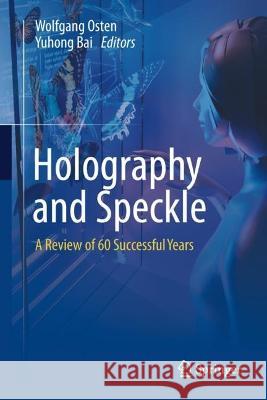Holography and Speckle: A Review of 60 Successful Years » książka



Holography and Speckle: A Review of 60 Successful Years
ISBN-13: 9783031368776 / Angielski
Holography and Speckle: A Review of 60 Successful Years
ISBN-13: 9783031368776 / Angielski
(netto: 691,70 VAT: 5%)
Najniższa cena z 30 dni: 655,41
ok. 22 dni roboczych.
Darmowa dostawa!
Dr. Wolfgang Osten is a retired full professor at the University of Stuttgart and former director of the Institute for Applied Optics ITO. His research is focused on new concepts for machine vision by combining modern principles of optical metrology, sensor technology and digital image processing. Osten is a Fellow of OSA, SPIE, EOS, SEM, and a senior member of IEEE. He has received the Gabor Award from SPIE, the Kingslake Medal from SPIE, the Vikram Award from SPIE, and the Leith Medal from OSA. He has published several books and more than 300 articles in peer reviewed journals.
Dr. Yuhong Bai is a full professor at CIOMP, Chinese Academy of Sciences. She is head of the Light Publishing Group, director and deputy editor-in-chief of the journals Light: Science & Applications and Light: Advanced Manufacturing. She is a member of the organizing committee of UNESCO’s International Year of Light and International Day of Light, and a board member of the Chinese Optical Society. She has co-edited three books and has published more than 70 peer-reviewed journal papers.
More than 40 peer-reviewed papers offer a wealth of information on the history, 3D displays, modern microscopy, metrology, deep learning, and tools for virtual reality.
An electronic version was published open access in the journal “Light - Advanced Manufacturing”, 2022.
1997-2026 DolnySlask.com Agencja Internetowa
KrainaKsiazek.PL - Księgarnia Internetowa









